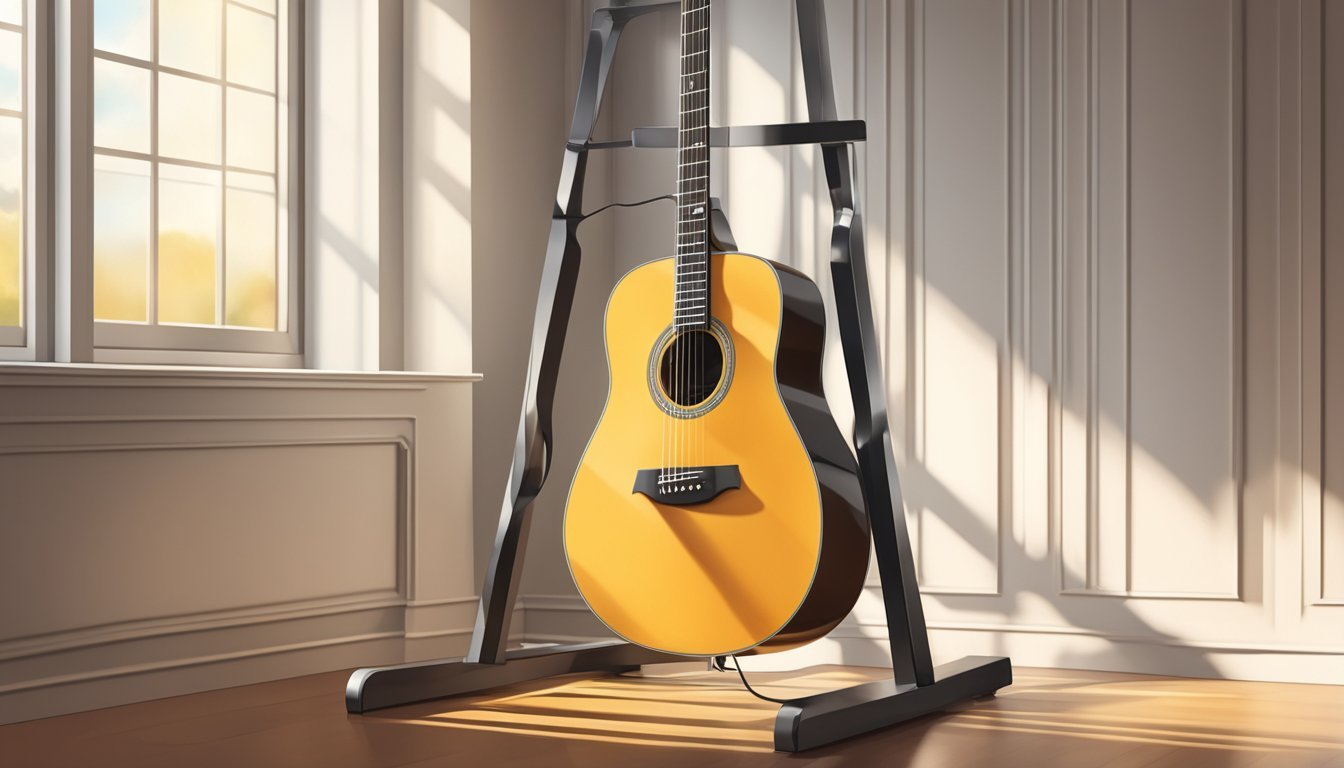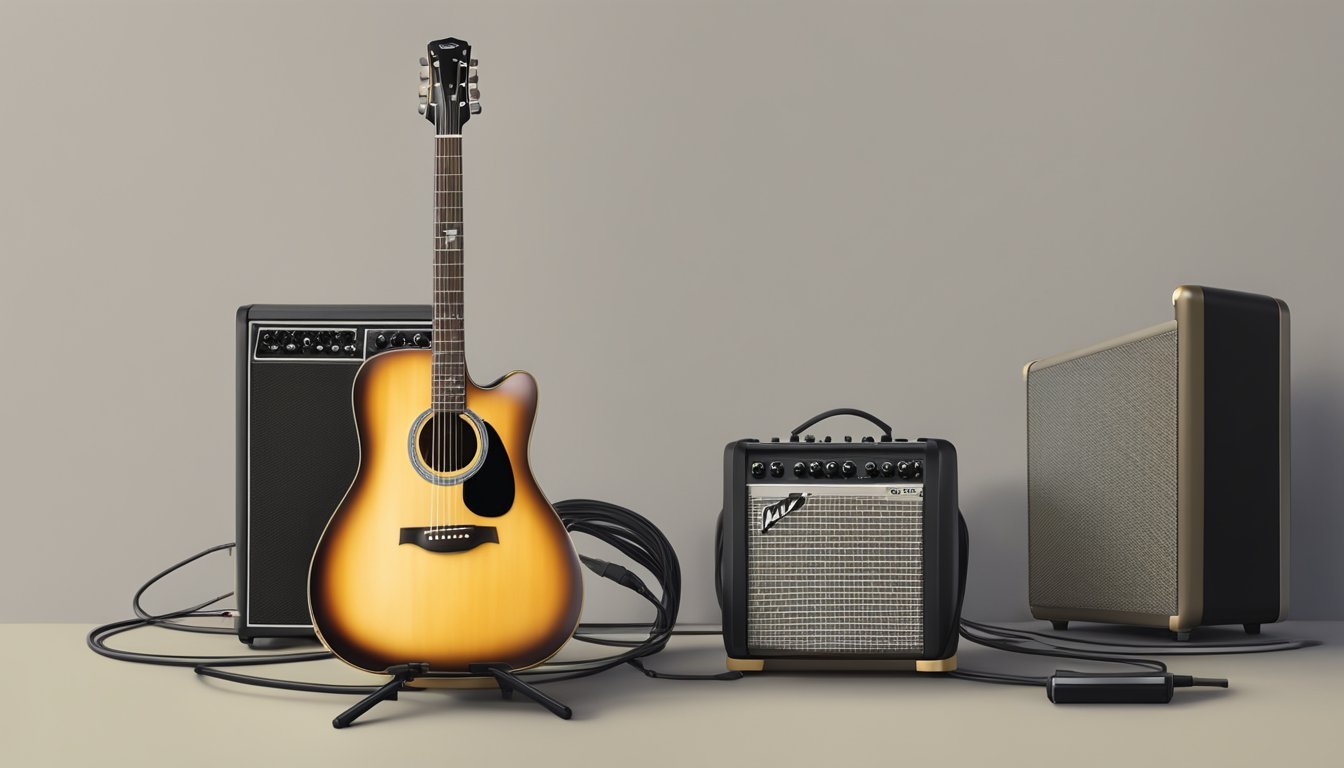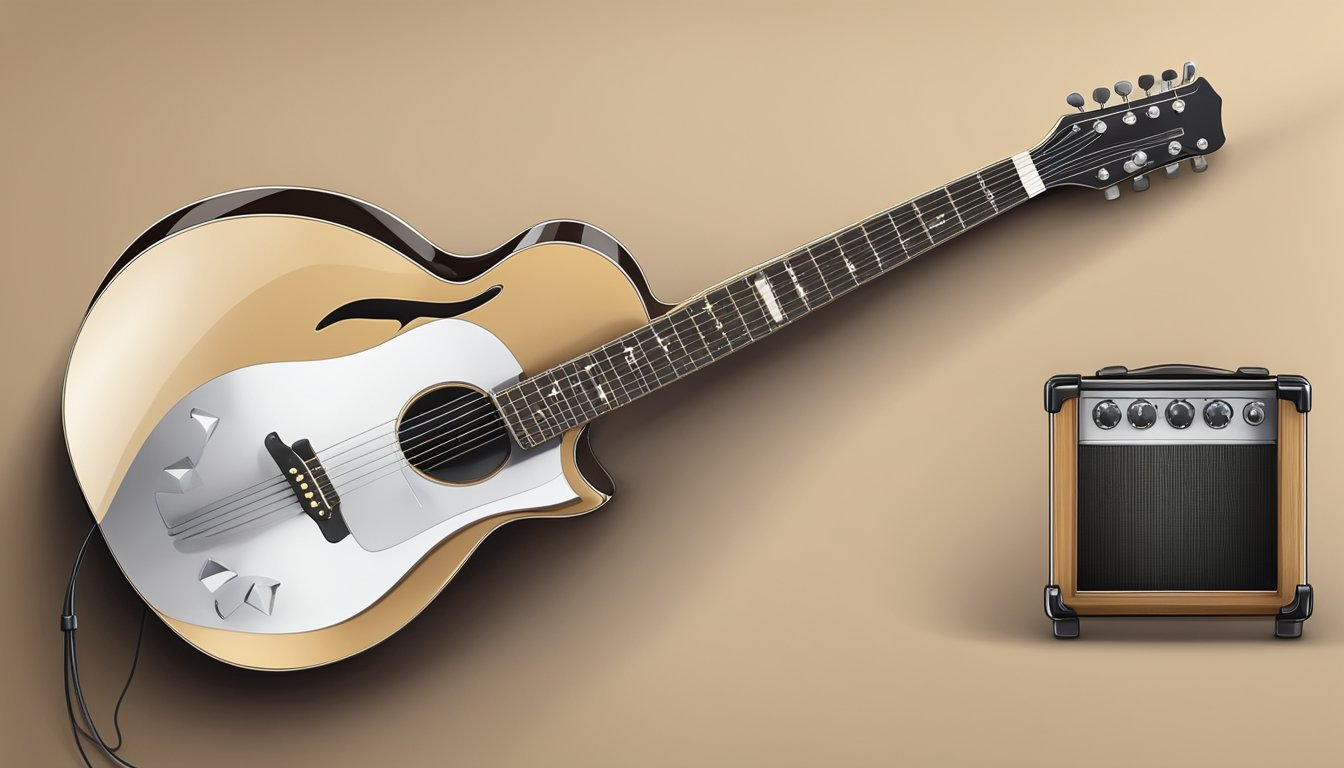An electric acoustic guitar is a blend of traditional acoustic sound with modern technology.
This type of guitar has built-in electronics that enhance its sound through amplification. This gives you the freedom to play both unplugged and plugged in.
Whether you want to strum chords around a campfire or perform on stage, this versatile instrument can adapt to your needs.

What sets an electric acoustic apart from a standard acoustic guitar is its added features, like pickups and tone controls.
These components allow you to adjust your sound and volume, making it easier to get the tone you desire in different settings.
Many musicians enjoy the rich acoustic quality while also taking advantage of the flexibility that amplification provides.
If you’re curious about how these guitars are constructed and what makes them appealing for different styles of play, keep reading to uncover all the details.
Key Takeaways
- Electric acoustic guitars combine traditional acoustic features with modern amplification technology.
- Built-in pickups help you achieve a variety of sounds for different performance settings.
- These guitars are versatile for both casual playing and professional performances.
Understanding Acoustic Electric Guitars

Acoustic electric guitars combine the traditional sound of acoustic guitars with modern technology for amplified performance.
They offer unique features that enhance playability and versatility for musicians.
History and Evolution
The acoustic electric guitar has a rich history that dates back to the early 20th century.
Originally, guitars were purely acoustic, relying on their hollow bodies for sound.
The need for louder instruments in performances led to the development of pickup systems.
As musicians sought to amplify their sound without losing the natural tonal qualities of the instrument, the electric guitar emerged, incorporating both acoustic elements and electronic technology.
This innovation sparked a new era in music, with various styles and genres taking advantage of the versatile sound.
Today, many players still revisit the question of “what is an acoustic guitar,” often blending acoustic and electric techniques to create unique musical expressions.
By the 1930s, guitars began to include microphones and pickups to amplify sound.
As technology progressed, built-in pickups and preamps became standard.
Now, many musicians prefer acoustic electrics for their ability to perform in larger venues while maintaining the essence of acoustic sound.
Acoustic vs. Electric Acoustic
When you compare acoustic guitars to acoustic electric guitars, the main difference lies in the added electronics.
Acoustic guitars, like dreadnought models, rely solely on their shape and wood for sound.
These instruments are great for intimate settings, but they can struggle in larger spaces.
On the other hand, acoustic electric guitars come equipped with a pickup system, which captures the vibrations of the strings and converts them to an electrical signal.
This allows you to connect to an amplifier.
Additionally, features like volume controls and tone adjustments help you shape your sound to fit different settings.
Key Components and Features
Acoustic electric guitars have a few key components that enhance their usability.
The pickup system is often a piezo-electric transducer located under the saddle.
This is crucial for converting vibrations into sound.
Most models include a preamp, which boosts the signal for amplification.
You’ll often find controls for tone and volume right on the guitar.
Some guitars feature a cutaway design, allowing easier access to upper frets.
This is particularly beneficial if you like to play solos.
Whether you’re performing on stage or jamming with friends, these features make acoustic electric guitars a smart choice for any player.
Construction and Materials

When it comes to electric acoustic guitars, the materials used play a big role in shaping the sound and feel.
You’ll notice how different woods affect tone, while the body shape impacts playability and sound projection.
Let’s dive into the details of common tonewoods, body shapes, and the neck and hardware.
Common Tonewoods
The type of wood used can greatly influence the quality of sound. Spruce is a popular choice for the top.
It delivers a bright, clear tone that resonates well.
You might also see mahogany used for the back and sides.
It offers warm, rich tones that add warmth to your music.
Sapele is another wood often seen in electric acoustic guitars.
It provides a similar sound to mahogany but with a bit more brightness.
For the fingerboard, rosewood or East Indian rosewood are common choices, known for their smooth feel and rich tonal characteristics.
Solid wood is preferred by many for its superior sound qualities compared to laminated options.
Body Shapes and Sizes
Electric acoustic guitars come in various shapes and sizes, affecting how they sound and feel.
The most common shapes include the dreadnought and concert.
Dreadnought guitars have a larger body, which gives them a booming sound great for strumming.
If you prefer something smaller, consider a concert shape.
It’s easier to handle and still produces a full sound.
You may also find grand auditorium shapes that combine features of both.
This versatile design works well for both strumming and fingerpicking.
The size can also affect projection and volume, so pick what feels right for you.
Neck and Hardware
The neck is crucial for playability and comfort.
A sapele neck is often used for its strength and stability, ensuring your guitar stays in tune.
For the fingerboard, you’ll typically encounter rosewood or other quality materials that feel smooth under your fingers.
In terms of hardware, look for sturdy tuning machines that make it easy to adjust your strings.
They come in a variety of materials, with stainless steel being the most common.
This combination of neck and hardware enhancements can really affect how your guitar plays and sounds.
Electronics and Sound
When it comes to electric acoustic guitars, the electronics play a huge role in shaping the sound.
Understanding the types of pickups, how amplifiers work, and the importance of EQ can really enhance your playing experience.
Types of Pickups
Pickups are essential for capturing the sound of your guitar.
There are a few main types you should know about:
-
Piezoelectric Pickups: Often found under the bridge, these pickups sense vibrations. They offer a clear, natural sound, making them popular among acoustic players.
-
Magnetic Pickups: These work by sensing the string vibrations and are more common in electric guitars. They can brighten the tone and provide a different character.
-
Expression System 2: This system, particularly from Fishman, combines both piezo and a microphone. It delivers a well-rounded sound, capturing the guitar’s natural resonance.
Amplifiers and Effects
When you want to amplify your electric acoustic guitar, you’ll typically use a guitar amplifier.
Finding the right amp can make a big difference.
Acoustic guitar amps like those from Takamine enhance the natural tones without altering them too much.
You can also add effects pedals for more sound options.
Reverb can create a sense of space, while delay can add depth.
Experimenting with different setups lets you find your unique sound.
EQ and Tone Shaping
EQ controls let you shape your guitar’s tone.
Most acoustic amps have basic EQ settings, usually offering treble, mid, and bass adjustments.
- Treble boosts the higher frequencies, adding brightness.
- Mid controls affect the presence and warmth.
- Bass can add depth to your sound.
Using EQ wisely helps you adapt your tone to different venues or styles.
Your guitar may sound different in each setting, so don’t hesitate to tweak the settings.
Playing and Performance

Playing an electric acoustic guitar combines the warmth of an acoustic with the versatility of electronics.
You can explore various techniques and utilize it in different performance settings, making it perfect for any guitarist looking to expand their sound.
Playing Techniques and Styles
When you play an electric acoustic guitar, you can experiment with a range of techniques.
Strumming chords can create a rich sound, while fingerpicking offers a more intricate style.
You might find yourself drawn to different genres, such as blues, where expressive bends and slides shine.
Chords & Techniques:
- Rhythm Guitar: Focus on strumming patterns that suit your style.
- Lead Guitar: Use slides and hammer-ons for a dynamic performance.
The built-in tuner is a handy feature, helping you stay in tune despite your strumming.
Whether you’re playing punk or soft folk tunes, the instrument’s versatility helps you adapt to any genre.
Live and Recording Applications
Electric acoustic guitars are fantastic for both live performances and studio recording.
For live gigs, you can plug into a PA system, enhancing your sound in larger venues.
Using effects pedals can add depth.
Live Performance Tips:
- Feedback Management: Position your guitar wisely to avoid unwanted feedback.
- Dynamic Range: Adjust your playing for soft ballads or energetic songs to engage your audience.
In recording, you have the option to capture the natural acoustic sound or amplify it.
The electric component allows for creative layering and richer sound.
Maintaining Your Instrument
Regular upkeep can keep your electric acoustic guitar in top shape.
Wipe down the strings after each play to remove oils and dirt.
Additionally, changing your strings regularly ensures optimal sound and playability.
Maintenance Tips:
- Temperature Control: Keep your guitar in a stable environment to avoid warping.
- Periodic Checkups: Inspect the electronics and wood for any signs of wear.
Investing the time in maintenance will extend the life of your instrument, allowing you to focus on playing your best.
Frequently Asked Questions
If you’re curious about acoustic-electric guitars, you’ve come to the right place.
Here, you can find answers to some common questions that many people have about these versatile instruments.
What’s the diff between an acoustic-electric and a regular acoustic guitar?
The main difference lies in the electronics.
An acoustic-electric guitar includes a built-in pickup and often a preamp.
This allows you to plug it into an amplifier, while a regular acoustic guitar relies solely on its hollow body to produce sound.
Are acoustic-electric guitars cool for beginners, or are they kinda tricky?
Acoustic-electric guitars can be great for beginners.
They offer the same feel as regular acoustic guitars but give you more options for playability and sound, especially if you want to perform.
With a little practice, you’ll find them easy to handle.
Do you need an amp to jam out on an acoustic-electric guitar?
Not necessarily.
You can play an acoustic-electric guitar unplugged just like a regular acoustic.
However, to take full advantage of its features and projects your sound during live settings, an amp is beneficial.
Why would someone pick an acoustic-electric guitar for playing tunes?
People often choose acoustic-electric guitars for their versatility.
You can play them acoustically at home or plug them in for performances.
This makes them a solid choice for musicians who want both options without needing two separate guitars.
Do acoustic-electric guitars have any downsides to them?
While they offer many advantages, acoustic-electric guitars can be more expensive than regular acoustic ones.
There’s also a bit of maintenance involved with the electronics, so some players prefer simpler models.
What’s a top pick for a quality acoustic-electric guitar?
One popular choice is the Yamaha FGX800C.
Many players go to it because it balances quality and affordability.
Plus, it sounds great whether you play plugged in or not.

